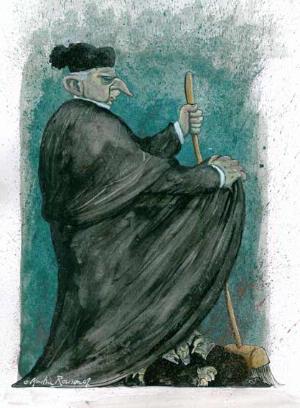This summer the Scottish Cardinal Keith O’Brien said that sex education in schools was like “state-sponsored sexual abuse” of children. And the Catholic Church should know a thing or two about sexual abuse of children.
It knows about other sorts of abuse too. In the ‘50s and ‘60s, in some British Catholic schools, hundreds of childhoods were blighted through sexual abuse, beatings or simply lack of care.
 Everyone knows Catholic priests abused and brutalised children in other countries. In the USA, the Los Angeles Diocese alone recently paid out $660 million to settle 550 cases out of court. In Ireland one Catholic order, the Christian Brothers, was forced to take advertisements in all the country’s national newspapers in 1998, apologising for years of brutal beatings and abuse.
Everyone knows Catholic priests abused and brutalised children in other countries. In the USA, the Los Angeles Diocese alone recently paid out $660 million to settle 550 cases out of court. In Ireland one Catholic order, the Christian Brothers, was forced to take advertisements in all the country’s national newspapers in 1998, apologising for years of brutal beatings and abuse.
But in Britain? Evidence is now piling up that it was as widespread here in the ‘50s and ‘60s as in those other countries. But British Catholics have been more successful in putting obstacles in the way of those victims, now (mostly) middle-aged men, who want to claim compensation for their lost childhoods.
There is a trickle, however, and every chance that in the next few years it will turn into a flood of the sort that has overwhelmed the American church. The response to a recent book by a survivor of abuse detailing his struggle to bring his case to trial has begun to elicit some startling responses. Unless they are all the work of fantasists, they suggest much wider and possibly more systematic abuse of children by Catholic priests and teachers in Catholic schools than has hitherto come to light.
The book, Conspiracy of Faith, is by Graham Wilmer and details how when he was 11, in 1963, he was sent to the Salesian College in Chertsey, run by the Salesian priests, a Catholic order. It was then a private school. Today it is state-funded.
Graham remembers his first day vividly: “We were ordered to sit down and be quiet, but not all of us were … With the stealth of an old lion, the old priest moved quickly from the front of the class to the back, where I was sitting, and struck me across the face with his open hand.” Graham soon discovered that “minor misdemeanours were punished by beatings by hand, fist, belt or cane.”
Three years later he discovered something altogether darker. A science teacher called Hugh Madley befriended him, and, for two years, used him regularly as a sexual plaything.
It finally ended in 1968. That year Graham’s best friend was killed in a rugby accident. He was asked to be an altar boy at a requiem mass, where he would be expected to receive Holy Communion. He couldn’t do it; because of the abuse he was in a state of mortal sin. So, at last, he told the school, though not his parents, what had been happening. Madley confessed when confronted by the school authorities.
This is what the principal of the Salesians in Britain, Father George Williams, did about it: he gave Madley a job in another school, the Salesian school in Battersea, south London, after he promised not to do it again. Once there Madley took charge of the cricket teams, taking boys to away matches and on camping trips. He taught there until he took early retirement, seven years ago.
When Graham did badly in his O-level exams the school threw him out. “I think I can say,” the headmaster, Father O’Shea, wrote to his father, “that the school has done a great deal for your son.” O’Shea knew exactly what the school had done for Graham, who endured years of dead-end jobs and failed relationships before he was able to put his life together again. Graham’s parents did not find out the truth for another 30 years.
In 1998, Graham decided to seek compensation. It has taken most of the last nine years to push the Salesians to the point of public confession. The Salesians’ lawyers darkly warned him that he would have a devil of a job proving anything. For three years they traded on Graham’s error, when he first wrote to the school, of spelling Madley’s name with an extra “e”. They had no record of a teacher called “Madeley”, they said. Then they gave him £20,000 so long as he did not pursue the matter, and they used his signature on this agreement to try, unsuccessfully, to stop him publishing his book.
When I asked the present head of the order in Britain, Father Michael Winstanley, whether Madley was the only sexual abuser employed in their schools, he paused for a long time before replying: “He is the only abuser who has confessed.”
And now Graham, who has set up a website as a point of contact for others who have suffered abuse, is getting a growing stream of emails from other Salesian pupils. These messages accuse several Salesian priests by name of sexual abuse. I can’t quote them directly because they have not been libel-proofed. There is much work to be done to turn these accusations into convictions, but there are signs that at least some of the former pupils will go down the path Graham has pioneered, and press charges.
More concrete evidence is also emerging from other sources. In recent weeks Father Winstanley has been given a detailed memorandum written by a former member of the Salesian order, telling him that sexual abuse was rife throughout Salesian schools in the ‘60s. It names nine priests. Graham Wilmer, who has seen the document, is passing some of these names on to the police.
What does the Catholic Church have to say about all this? First, a report by the US-based Catholic League for Religious and Civil Rights in February 2004 seeks “to put the recent scandal in the Catholic Church in perspective…. To discuss the incidence of sexual abuse committed by Roman Catholic priests without reference to the level of offence found among the clergy of other religions, or to that of other professionals, is grossly unfair.” It claims that the Protestants have more abuse allegations against them than the Catholics. Even if true this is hardly a defence.
Secondly, they say that it’s all a long time ago, and the Church has changed. To some extent they have been forced to change. These days the Christian Brothers, Jesuits and Salesians would lay themselves open to an assault charge if they attacked children, and they insist that they now report any sexual abuser to the authorities.
But a Panorama investigation in 2006 found seven priests with child abuse allegations made against them living in and around the Vatican, being protected by the Holy See, which hardly suggests a church ready to change its ways. England’s top Catholic prelate, Cardinal Cormac Murphy-O’Connor, is known to have allowed a paedophile to continue working as a priest, despite warnings that the man would re-offend.
It is only seven years since Madley took early retirement, and perhaps some of those yet to be charged also stuck around as long. Perhaps they teach today. Just how many boys suffered fates similar to Graham Wilmer at the hands of Madley and others in the ‘70s and ‘80s may not become clear for some time.
The new Schools Secretary, Ed Balls, should now demand much clearer signs that the Catholic Church understands the dreadful nature of its crimes against children. Otherwise, he should ensure that they cannot run schools. ■

